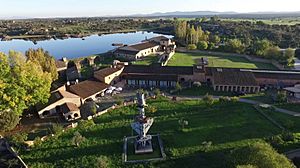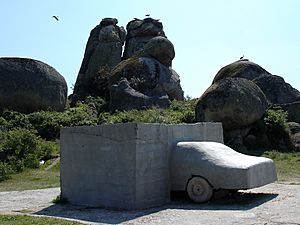Museo Vostell Malpartida facts for kids

Museo Vostell Malpartida, aerial view, 2015.
|
|
| Established | 1976 |
|---|---|
| Location | Malpartida de Cáceres, Spain |
| Type | Art museum |
| Collections | Wolf Vostell, Fluxus & Conceptual art |
| Founder | Wolf Vostell & Mercedes Vostell |
| Architect | Javier Manso Rapado |
The Museo Vostell Malpartida is a special art museum located in the Spanish village of Malpartida de Cáceres. This village is in the region of Extremadura, west of the city of Cáceres. The museum is dedicated to the amazing artworks of a German artist named Wolf Vostell. He was a painter, sculptor, and a key figure in art movements called Fluxus and Happening.
The museum was started by Wolf Vostell and his wife, Mercedes Vostell, in 1976. Today, Mercedes Vostell is the artistic director, guiding what art is shown. José Antonio Agúndez García is the general director.
Contents
History of the Museum
Wolf Vostell loved to create art in unusual ways. In 1976, he made a sculpture in a place called Los Barruecos. He used his own black Opel Admiral car from 1970, which he had driven with his family through Extremadura. He called this sculpture VOAEX (Journey in the Upper Extremadura). Two years later, in 1978, he created another sculpture called The dead who is thirsty (El Muerto que tiene Sed). The VOAEX sculpture was officially opened on October 30, 1976, and that same day, the Museo Vostell Malpartida was founded.
The museum covers a large area, about 14,000 square meters. Part of the museum is in an old washhouse that was used in the 1700s and 1800s. This was a place where wool from traveling sheep herds was washed using water from the Barruecos de Abajo pond. The washhouse has several rooms where different tasks were done, like shearing sheep and weighing wool.
Since 1988, the German Goethe-Institut has worked with the museum. This partnership began when they helped Wolf Vostell find 20 motorcycles for a sculpture by Salvador Dalí. Since then, the Goethe-Institut has supported many exhibitions, concerts, and book releases at the museum.
In 1994, the government of Extremadura helped to completely fix up the museum buildings. After Wolf Vostell passed away in 1998, Mercedes Vostell became the artistic director. In 2005, the government bought Wolf Vostell's personal archive for the museum. This archive is now a very important part of the museum. It helps art historians, journalists, students, and anyone interested in art to learn more about Vostell's work.
The Museo Vostell Malpartida is very popular. In 2016, over 47,000 people visited it. In 2017, the National Geographic Society in Spain listed it as one of the top 10 must-see museums in Spain. In 2018, the museum received the Gold Medal of Merit in the Fine Arts from the Spanish Government. This is a very important award for art and culture.
Art Collections and Exhibitions
The museum is divided into four main parts. Three parts show permanent collections of art. These include works from Wolf and Mercedes Vostell's own collection, and also a collection from an Italian art collector named Gino Di Maggio. He specifically collected art by Fluxus artists. The fourth part of the museum features temporary exhibitions, which change regularly, showing art by different Conceptual artists.
The museum also has an outdoor exhibition in the Los Barruecos nature reserve. This is where you can see the large sculptures VOAEX (from 1976) and El muerto que tiene Sed (from 1978).
Wolf and Mercedes Vostell Collection
This collection offers a wide and interesting look at Wolf Vostell's art. It includes five key works that are very important to the museum:
- Automobile-Fever (Auto-Fieber) (1973)
- Fluxus-Buick-Piano (1988)
- Endogene Depression (1975–1978)
- Requiem for the forgotten (Réquiem por los olvidados) (1986)
- The Breakfast of Leonardo da Vinci in Berlin (Das Frühstück von Leonardo da Vinci in Berlin) (1998)
Many of these artworks use everyday objects in new and surprising ways. You can also see five sculptures called The Concrete Bulls (Los Toros de Hormigón) (1990), and four large reliefs called Trashumancia (1993). There are also paintings like The Burial of the Sardine (El Entierro de la Sardina) (1985), The Billard Girls (Las Chicas del Billar) (1986), Mythos Berlin (1987), and Estrella Seelenfreund (1994).
The collection also has many paintings from Vostell's series like El muerto que tiene Sed and VOAEX. You can also see plans for sculptures like Icarus and Tanit. These works show how Vostell explored different ideas in his art. Two other notable works are Transmigration III (1958–1959), which includes a television set, and Foreign mountain (Montaña extranjera) (1958). This last piece was one of the first artworks Vostell created in Extremadura.
In the museum's garden, there is a huge 16-meter tall sculpture by Wolf Vostell. It's called Why did the process between Pilate and Jesus take only two minutes? (Por qué el proceso entre Jesús y Pilatos duró solamente dos minutos?) (1996). This amazing sculpture is made from parts of a Russian Mig-21 airplane, two cars, computer monitors, and three pianos!
Fluxus Collection
The Fluxus collection was given to the museum by an Italian art collector named Gino Di Maggio in October 1996. Di Maggio had a close relationship with many Fluxus artists. He collected their works and showed them in his own art spaces.
The collection includes about 250 artworks, such as installations, paintings, and sculptures. It features works by 31 artists from Europe, North America, and Asia. These artists were part of the Fluxus and Happening movements in the late 1950s and 1960s. These movements aimed to bring art into everyday life and create new ways of expressing ideas, often mixing different art forms. The collection also includes photographs, videos, and writings that explain these artistic actions.
Fluxus Artists in the Collection
- Eric Andersen
- Ay-O
- George Brecht
- Giuseppe Chiari
- Philip Corner
- Willem de Ridder
- Robert Filliou
- Henry Flynt
- Al Hansen
- Geoffrey Hendricks
- Dick Higgins
- Joe Jones
- Allan Kaprow
- Milan Knížák
- Alison Knowles
- Shigeko Kubota
- Jean-Jacques Lebel
- George Maciunas
- Walter Marchetti
- Charlotte Moorman
- Yoko Ono
- Nam June Paik
- Benjamin Patterson
- Takako Saito
- Antonio Saura
- Mieko Shiomi
- Gianni-Emilio Simonetti
- Daniel Spoerri
- Ben Vautier
- Wolf Vostell
- Robert Watts
- Emmett Williams
Movies About the Museum
Several movies have been made about Wolf Vostell and the museum:
- 1976: VOAEX, by Ulrike Ottinger.
- 1982: Wolf Vostell – Mitten am Rande der Welt, (part 1 | part 2) by Jürgen Böttcher.
- 1994: Traumziele, Zwischen Berlin und Malpartida – auf den Spuren von Wolf Vostell, by Werner Filmer and Ernst – Michael Wingens.
- 2015: Malpartida Fluxus Village, by María Pérez.
- 2016: Documentary, by Jesús Alonso Ovejero for RTVE.
See also
 In Spanish: Museo Vostell Malpartida para niños
In Spanish: Museo Vostell Malpartida para niños


